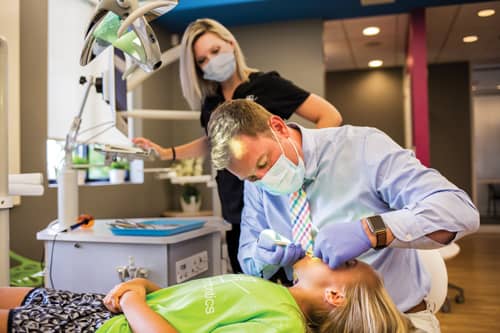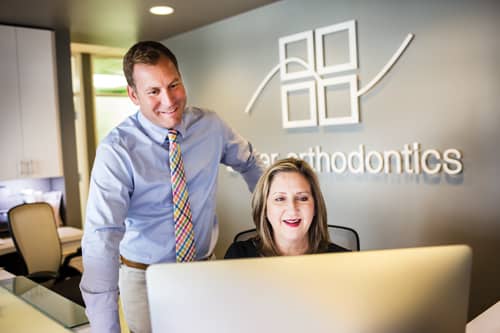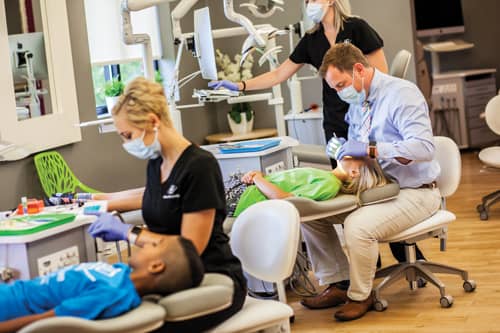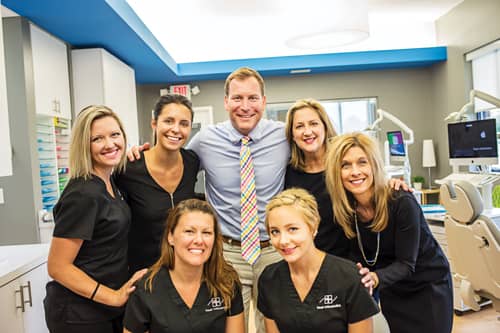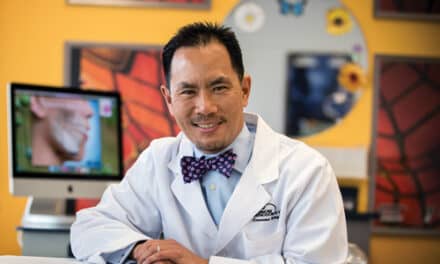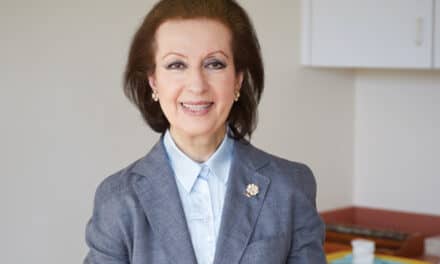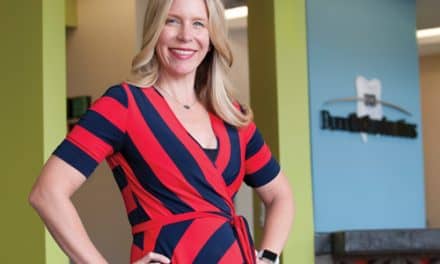Efficiency is by far one of the most common words thrown around when ?discussing the key concepts behind a successful orthodontic practice. While everyone nods along about the importance of efficiency, many are left wondering, what does efficiency actually look like in an orthodontic practice? For Missouri-based orthodontist Matt Bauer, DMD, MS, it means a treatment philosophy that cuts treatment times and practice overhead while still producing satisfied and happy patients.
Tangled Orthodontic Web
Retainers typically mark the last phase of a patient’s orthodontic treatment. For Bauer, however, they mark the beginning of his career trajectory. While he was in college, pursuing a pre-med track, with the intention of pursuing a career as a pediatrician, his father, southern Illinois-based orthodontist Joachim Bauer, DDS, MS, asked him if he would be interested in making retainers for his practice. The senior Bauer recognized that Matt was quite crafty and good with his hands. Bauer was up for the task and went to Great Lakes Orthodontics in Buffalo, NY, to take their basic and advanced retainer course. Once back in his father’s practice, Bauer found that he was not only very good at making retainers, but that he enjoyed doing it. Soon, his father offered him the opportunity to work with patients directly, trying on and fitting the retainers. That patient interaction inspired Bauer to change his plans and to go on to dental school at Southern Illinois University, followed by his residency at Saint Louis University (SLU)—familiar territory as Bauer’s father had taught at SLU for decades. Upon completing his residency, Bauer joined his father’s practice. The practice expanded again 2 years later when father and son were joined by Bauer’s younger sister, Beth Hite, DMD, MS.
After 5 years total working with his family, Bauer knew it was time to set up his own practice—and unlike many younger orthodontists practicing today, he knew he wanted to build it from the ground up.
Family was an important factor in Bauer’s decision on where to practice. In addition to his immediate family connections to the orthodontic community, Bauer’s father-in-law, Kevin Walde, DDS, MS, is also an orthodontist, who practices in Washington, Mo. In fact, Bauer’s father once taught Walde at SLU. Add to this mix, one brother-in-law who is an orthodontist and another who is a dentist, as well as Bauer’s wife, Kate, who heads up Kate Bauer Design, which specializes in orthodontic interior space planning and design, and you’ve got what Bauer calls “this crazy tangled web of orthodontists.” The desire to find a way to stay within this web and build a practice in between his father and sister’s practice and his father-in-law’s practice brought Bauer and his wife to the small town of Cottleville, Mo.

A Practice of His Own
[sidebar float=”right” width=”250″]
Practice Profile
Practice name: Bauer Orthodontics
Location: Cottleville, Mo
Number of chairs: 6
Years in practice: 11 years total, ?6 years in my office
Education: Southern Illinois University (DMD); Saint Louis University (MS, Orthodontics)
Average patients per day: 65
Starts per year: 450
Days worked per week: 3.5 days
Staff size: 6
Top five products used: BioQuick® Brackets and QuicKlear® Brackets (Forestadent USA); Transbond™ Plus Self-Etching Primer (3M); Assure Plus All Surface Bonding Resin (Reliance Orthodontic Products); Invisitain retainer material (Invisitain LLC)
Practice website: bauerortho.com [/sidebar]Once in Cottleville, Bauer had to start from scratch to build Bauer Orthodontics’ patient base, and he chose to rely on tried and true methods. While his practice was still under construction, Bauer moved to the area in advance of opening for business to knock on doors and take dentists to lunch. In addition, he sent out Christmas cards to anybody in the area who looked like a dentist to announce his upcoming opening. Fortuitously, one of those Christmas cards mistakenly wound up delivered to an area orthodontist. The orthodontist wanted to retire, but was not in a position to sell his building as he was leasing. However, he had some patients he wanted finished. Bauer was offered the opportunity to purchase those existing contracts from him, giving his practice a much-needed shot in the arm once the doors opened.
But even with that fortuitous opportunity, those early days were not without their stresses. Yes, he had 5 years to observe how his father’s established practice was run, but once in his own practice he realized there was so much more to it.
“You take it for granted. At my dad’s practice, it was a well-oiled machine. You just showed up for work and did the orthodontics and had all the great staff behind you to support you while you did your thing. When I got out on my own, I saw that there was so much more to this,” Bauer says.
“I always knew it was going to be difficult and stressful. I thank God I had 5 years under my belt and saw what a private practice looked like. I had an idea of how it ran, but didn’t have the full weight of responsibility on my shoulders nor all the nitty gritty details.”
Bauer also credits his wife Kate for the success of what has emerged. “We truly did it together,” he says. Moreover, the experience helped her get an up close and personal view of what it takes to start a practice, which has informed the work she undertakes for her orthodontic interior space planning and design clients. “This experience has helped her be better at what she does,” he says.
For Bauer, the first 3 years in private practice were the most difficult. “I’ve heard before that it takes 5 years to build up a practice. I think that’s a very accurate statement. There were times where I couldn’t pay myself. I had to pay my employees first,” he recalls. “But I would tell anybody that it is worth the struggle to have your own practice and hang up your own shingle.”
In fact, the ability to hang up his own shingle is part of what makes the profession so special to Bauer.
“What makes orthodontics so special is the fact that I have my practice. I built it. I have a small team that is like family to me. I get to decide how many days I want to work. I get to be with my family. That is the beauty of it. It’s not that orthodontics is really that cool. It is—but really, it’s the ability to create that opportunity to live the life you want to live. You lose control [of that] when you work for somebody else.”

Secret to Success
Bauer attributes much of his current success to the fact that he had those first 5 years, while practicing with his father, to focus on the orthodontics and hone his craft, while leaving much of the business side of things to someone else.
Bauer credits the Roth Williams course he took immediately after finishing his residency with helping him to develop his own treatment philosophy. The course gave him a greater understanding of functional occlusion—that it’s not just about straightening teeth, but about how the jaw and muscles work together.
“That’s invaluable,” he says. “Just being able to accurately treatment plan a case consistently—knowing what you’ve got to treat before you start treating, instead of just throwing braces on and hoping everything works out.”
But once the doors to his own practice were open and his staff in place, Bauer realized he needed to be equally concerned about clinical and practice efficiency. This meant refining his treatment philosophy further for it to really speak to how he wanted to practice. Even though he agreed with the fundamentals of the Roth philosophy, which focused on functional occlusion, the mechanics felt “clunky” and “old.” More specifically, Bauer believed he was using too many wires.
“Every time a patient came in, they were getting a new wire,” he recalls.
He knew that the new wire materials on the market were meant to work longer. “It’s almost like you’re cheating,” he says. “You’re buying this great wire that has these great properties and you’re not letting it do its job. You’re taking it off before you even let it do its job. You’re not trusting it. That’s where the Roncone course came into play.”
The “Roncone course” Bauer speaks of is the JSOP (Just Short of Perfect) and Roncone PhysioDynamicSystem (PDS) courses, created and led by Ron Roncone, DDS, MS, which focus on effective diagnosis and efficient treatment planning. Bauer was first introduced to the JSOP course through a 1-day teaser course while he was practicing with his father. At the time, the father-son practice was humming along and Bauer felt like the mechanics he was working with were good enough. So he didn’t make any changes. Once he was on his own, however, and finally had a moment to come up for air from the stresses of setting up a solo practice, he took stock of his mechanics. He realized they weren’t serving him well.
When Bauer started reading about the JSOP and PDS courses this time around, he remembered that Roncone was also Roth-trained and that he seemed to share Bauer’s belief that you could hold these core principles of the Roth philosophy but that there was an opportunity to clean up the mechanics and use newer materials. “That’s how I got interested in the PDS system,” he says.
So, what is the impact of the lessons Bauer learned from the Roncone courses? He found the efficiency he craved.
As Bauer describes it, a Roth orthodontist would traditionally go up to a full-sized stainless-steel wire, while Roncone’s prescription, which uses wires produced by Forestadent USA, builds in more torque, allowing the clinician to stay in a smaller wire. “So, you really only have to go up to the 19/25 and it doesn’t have to be stainless steel. It can be TMA,” says Bauer. As a result, by trusting the NiTi wires he uses, the practice’s wire inventory is reduced.
“Immediately, from an inventory standpoint, it takes down the number of wires you need to worry about; that then necessarily reduces the number of wire change appointments you would need to treat a case,” he points out. “As a result, you’re seeing a drastic decrease in the number of appointments a patient needs and an increase in the interval between visits.” In Bauer’s office, depending on the case, that translated to a reduction of appointments over the course of treatment from 15 to 18 appointments to six or seven appointments. Not only did this dramatically improve his practice’s efficiency and open up his schedule (which he had also switched to “like things at like times” as recommended by Roncone), but it also made for a happier, more satisfied patient.
“When I came back [from completing the Roncone course], I started five cases. I saw those cases going so well that I actually started taking appliances off my other cases that were already in the Roth appliance and rebonding them because I felt that would be more efficient—and it ended up being more efficient. So, I was cutting time off treatment plans by even switching midcourse with the appliance.”

Small Is Fine
Bauer is quite happy with his small practice in a small town. While the area is competitive with about 15 orthodontists within a 10-mile radius, the town offers Bauer, his wife, and their four young children, the lifestyle that they want. For him, future plans for practice growth aren’t about multiple locations or satellites; rather it’s about the possibility of adding another chair or a couple more staff members to his team of six.
Bauer recognizes that many residents and young orthodontists don’t see a small, solo, private practice as an option any more. As a member of the clinical faculty at SLU, he has heard firsthand how the majority of residents, who are saddled with debt and want financial stability, are gravitating towards larger group practices. While Bauer understands the draw, he hopes residents still consider going out on their own, and that when they do, that they focus in on efficiency.
“Orthodontic residency is a lot of information thrown at you at once, and it’s great; but it’s really hard to take all that knowledge and be efficient. To really be efficient in a private practice setting, you have to have your philosophy down, you have to know your appliances, you have got to know your materials. I’m not one to say that you have to do it this way or you’re doing it wrong. With any of the philosophies out there, as long as you understand the system that you are using—or misusing—you can be as efficient as possible. For me that’s where the Roth foundation comes in because knowing exactly what you are treating and then accurately executing your treatment plan from the beginning, that’s huge,” he says.
And for that orthodontist building a new practice, he would add that this efficiency is one of the best marketing tools you can have. For example, Bauer—whose practice focuses on internal rather than external marketing—sees his treatment times as one of the most impactful marketing messages his patients can share with their friends and family.
“My treatment times have gone from 20 to 24 months when I was working in my dad’s practice to 14 to 16 months now [after completing the Roncone program]—and we’re still finishing with the same results. There’s no bigger practice builder in my opinion than to be consistent like that,” he says.
And when a prospective patient asks why Bauer can get it done so much faster? Bauer responds, “‘Well, we trust the materials.’ To have the patients out and about that can back [that fact] up: That is effective marketing for me.” OP

